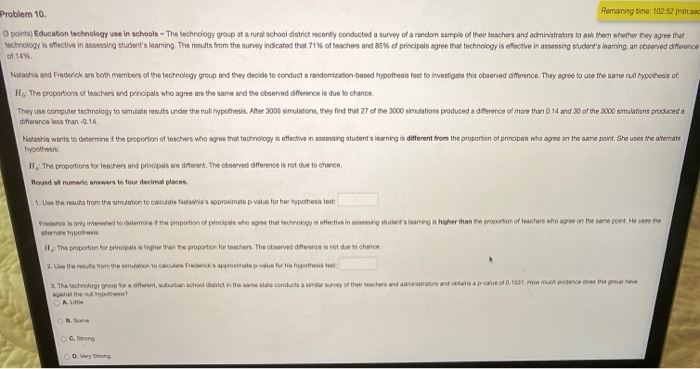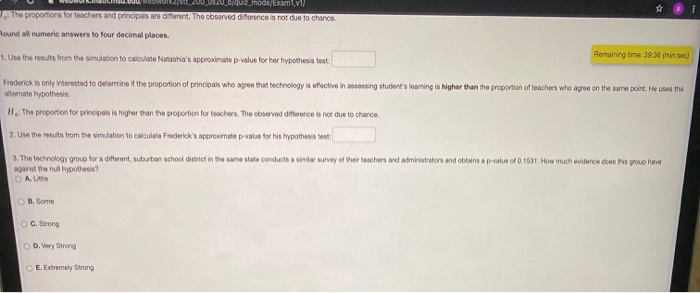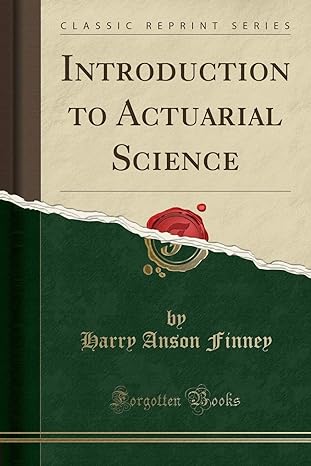Problem 10. Remaining time: 102 52 min.se pointsEducation technology use in schools - The technology group at a rural school district recently conducted a survey of a random sample of their teachers and administrators to ask them whether they agree that technology is elfective in assessing student's learning. The results from the survey indicated that 71% of teachers and 85% of principais agree that technology is effective in assessing student's learning, an coserved difference of 14% Natasha and Frederick are both members of the technology group and they decide to conduct a randomization-based hypothesis toet to livostgato this observed difference. They agree to use the same ruil hypothesis of Hj: The proportions of teachers and principals who agree are the same and the observed difference is due to chanos, They were computer technology to simulate results under the run hypothesis. After 3000 simulations, they find that 270 10 3000 simulations produced a difference of more than 0.14 and 30 of the 2000 simulations produced a difference less than-0.14 Natashia wants to determine if the proportion of teachers who agree that technology is effective in messing student's learning is different from the proportion of principals who agree on the same pakt. She uses the attemate hypothesis H,: The proportiora fotos and principals are different. The observed difference is not due to chance Round numericanswers to four decimal places 1. Use the results from the simulation to calculates to promote p value for her hypothesis test Verkry wrested to me a proportion of principals who are the technology is the industaning in higher than the proportion of teachers who ayee on the same porten where you H. The proportion for principis higher than the proportion for teachers. The observed derence is not due to chance 2. Une restrom the motion to cardics proximale vietor a post 3. The dog youp for a frent, but which in the same to conducts a similar survey of their chers and administrators and an af 1851. How much evidence des are C Afie Strong D. Very Song 3. The technology group for a different, courban school district in the same state conduct a similar survey of their teachers and administrators and obtain a p-value of 0.1531. How much evidence does this group have against the hypothesi? A. OB. Bome OC Song D. Very Strong OL. Extreme Song Problem 10. 13 points) Education technology use in schools - The technology group at a rural school district recently conducted a survey of a random sample of their teachers and administrators to ask them whether they agree that technology is effective in assessing student's learning. The results from the survey indicated that 71% of teachers and 85% of principals agree that technology is effective in assessing student's furning an observed derece of 14% Natashia and Frederick are both members of the technology group and they decide to conduct a randomization based hypothesis test to investigate this observed difference. They agree to use the same nut hypothesis of Ho: The proportion of teachers and principals who agree are the same and the observed difference is due to chance They use computer technology to simulate results under the rul hypothesis. After 3000 simulations, they find 27 of the 3000 simulations produced a difference of more than 0.14 and 30 of the 3000 smulations produced a difference less than 0.14 Natasha wants to determine the proportion of teachers who agree that technology selective in assessing student's learning is different from the proportion of principals who agree on the same point these tornato hypothesis: The proportions for teachers and principals are different. The served difference is not due to chance Round will numerio answers to four decimal place. Loqmod/Exam, The proportions for teachers and principals are morent. The coserved difference is not due to chance Round all numeric answers to tour decimal places Remaining time: 39.36 msc) 1. Use the results from the simulation to calculate Natasha's approximate p-value for her hypothesis tot Frederick is only merested to determine the proportion of principain who agree that technology offective in assessing student's learning in higher than the proportion of teachers who agree on the same point. He uses the atlypothesis H. The proportion to principals in higher than the proportion for teachers. The observed difference is not due to chance. 2. Use the rests from the matton to calculate Frederick's appro imate po volue for his hypothesis test 3. The technology group for a different, suburban school district in the same state conducta uma survey of their teachers and administrators and obtains a p value of 0.1891. How much evidence does this group have against the nullypothe? AU B. Some OG Strong OD. Very Strong E. Extremely Strong Problem 10. Remaining time: 102 52 min.se pointsEducation technology use in schools - The technology group at a rural school district recently conducted a survey of a random sample of their teachers and administrators to ask them whether they agree that technology is elfective in assessing student's learning. The results from the survey indicated that 71% of teachers and 85% of principais agree that technology is effective in assessing student's learning, an coserved difference of 14% Natasha and Frederick are both members of the technology group and they decide to conduct a randomization-based hypothesis toet to livostgato this observed difference. They agree to use the same ruil hypothesis of Hj: The proportions of teachers and principals who agree are the same and the observed difference is due to chanos, They were computer technology to simulate results under the run hypothesis. After 3000 simulations, they find that 270 10 3000 simulations produced a difference of more than 0.14 and 30 of the 2000 simulations produced a difference less than-0.14 Natashia wants to determine if the proportion of teachers who agree that technology is effective in messing student's learning is different from the proportion of principals who agree on the same pakt. She uses the attemate hypothesis H,: The proportiora fotos and principals are different. The observed difference is not due to chance Round numericanswers to four decimal places 1. Use the results from the simulation to calculates to promote p value for her hypothesis test Verkry wrested to me a proportion of principals who are the technology is the industaning in higher than the proportion of teachers who ayee on the same porten where you H. The proportion for principis higher than the proportion for teachers. The observed derence is not due to chance 2. Une restrom the motion to cardics proximale vietor a post 3. The dog youp for a frent, but which in the same to conducts a similar survey of their chers and administrators and an af 1851. How much evidence des are C Afie Strong D. Very Song 3. The technology group for a different, courban school district in the same state conduct a similar survey of their teachers and administrators and obtain a p-value of 0.1531. How much evidence does this group have against the hypothesi? A. OB. Bome OC Song D. Very Strong OL. Extreme Song Problem 10. 13 points) Education technology use in schools - The technology group at a rural school district recently conducted a survey of a random sample of their teachers and administrators to ask them whether they agree that technology is effective in assessing student's learning. The results from the survey indicated that 71% of teachers and 85% of principals agree that technology is effective in assessing student's furning an observed derece of 14% Natashia and Frederick are both members of the technology group and they decide to conduct a randomization based hypothesis test to investigate this observed difference. They agree to use the same nut hypothesis of Ho: The proportion of teachers and principals who agree are the same and the observed difference is due to chance They use computer technology to simulate results under the rul hypothesis. After 3000 simulations, they find 27 of the 3000 simulations produced a difference of more than 0.14 and 30 of the 3000 smulations produced a difference less than 0.14 Natasha wants to determine the proportion of teachers who agree that technology selective in assessing student's learning is different from the proportion of principals who agree on the same point these tornato hypothesis: The proportions for teachers and principals are different. The served difference is not due to chance Round will numerio answers to four decimal place. Loqmod/Exam, The proportions for teachers and principals are morent. The coserved difference is not due to chance Round all numeric answers to tour decimal places Remaining time: 39.36 msc) 1. Use the results from the simulation to calculate Natasha's approximate p-value for her hypothesis tot Frederick is only merested to determine the proportion of principain who agree that technology offective in assessing student's learning in higher than the proportion of teachers who agree on the same point. He uses the atlypothesis H. The proportion to principals in higher than the proportion for teachers. The observed difference is not due to chance. 2. Use the rests from the matton to calculate Frederick's appro imate po volue for his hypothesis test 3. The technology group for a different, suburban school district in the same state conducta uma survey of their teachers and administrators and obtains a p value of 0.1891. How much evidence does this group have against the nullypothe? AU B. Some OG Strong OD. Very Strong E. Extremely Strong










